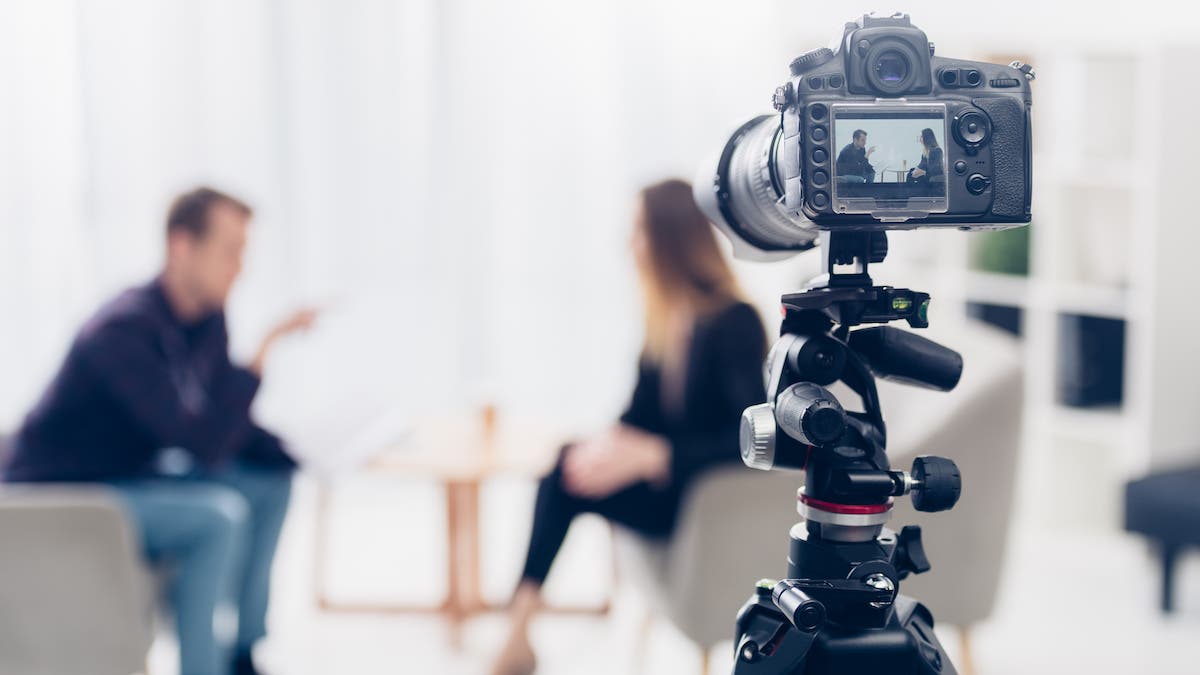From the time-honored techniques of traditional documentary filmmaking to the nuances of on-camera podcast interviews and the investigative depth of documentary-style journalism, filmmakers have a wide range of interview styles.
Whether you’re crafting a feature-length or short-form piece, the way you approach an interview can dramatically alter the tone and feel of your documentary. It’s a delicate storytelling dance, where the interview often takes center stage. It’s where people’s lives unfold in front of the lens, emotions are captured, and narratives are shaped.
Different Video Interview Styles
It’s important to consider how we present an interview so that its impact is maximized. Here are some of the different interview formats for documentaries.
Live (Synchronous)
These interviews happen in real-time. Think of news documentaries and real-time events, or talk shows such as podcasts. The immediacy of these interviews captures raw, unfiltered reactions and emotions. For documentaries, this style can be used to capture events as they unfold, lending authenticity and urgency to your audience.
Pre-Recorded (Asynchronous)
A staple in most documentaries, this type offers editing flexibility without time restraints — ensuring only the most relevant or impactful content makes the final cut. It’s the most common type of interview style, offering filmmakers flexibility in post-production. It allows you to weave together the most poignant parts of an interview, crafting a compelling narrative.

Remote Interviews
Increasingly popular due to technological advancements, remote interviews are conducted via video conferencing tools such as Skype, Zoom, or the plethora of other sites and companies that offer high bandwidth video and audio streams.
While they lack the intimacy of in-person interviews, they offer a broader range of possibilities, allowing you to interview subjects from different geographical locations.

Man-on-the-Street Interviews
These are impromptu interviews conducted with ordinary people in public places. While not common in feature-length documentaries, they are often used in short-form documentaries and news features to gauge public opinion or capture spontaneous reactions.
Panel Interviews
Involving multiple subjects and often a moderator, panel interviews are excellent for exploring different perspectives on a topic. They are commonly used in educational documentaries or pieces that aim to provide a comprehensive view of an issue.
Vox Pop
This “Voice of the People” style involves short, quick interviews with different groups of people to get a variety of opinions on a single topic. It’s often used in news documentaries to provide a snapshot of public sentiment.
Video interviews determine the tone and direction of your documentary, whether they are live, pre-recorded, remote or on-location.
Different Interview Styles
Beyond the mere format of an interview, the chosen style plays a pivotal role in shaping and driving the narrative forward. Delving into a variety of techniques not only offers versatility but also provides filmmakers with the tools to vividly bring their subject’s story to life. These can help create a deeper connection with your subject and the audience.
Off-Camera Interview
This is a classic documentary style where the interviewer remains unseen and often unheard. The spotlight is solely on the subject, allowing viewers to lean deep into their narrative. This style is particularly effective when the subject’s story is intense or deeply personal, as it minimizes distractions and creates an intimate atmosphere.
Direct-Address Interview
Here, subjects engage directly with the audience, breaking the fourth wall. This style is often seen in personal journey documentaries or pieces where the subject has a direct message or call to action for viewers. It establishes an immediate and intimate bond, making the audience feel spoken to directly.

Hosted Conversation
Think of on-camera podcast interviews — an on-screen host or journalist guides the conversation, adding layers of context, perspective, and sometimes even debate. The presence of a host can make the interview feel more structured and useful when discussing complex or controversial topics.
Cinematic Approach
This style extends beyond simple spoken word. It emphasizes visual storytelling with dramatic lighting, evocative backdrops, and strategic camera angles. The aim is to enhance the narrative, making it visually arresting. It’s less about the raw content and more about the overall mood and atmosphere, making the interview feel cinematic.
Narrative-Driven Interview
This style is structured around a particular storyline or narrative arc. The questions guide the subject through a specific story, often chronologically. It’s commonly used in biographical documentaries or pieces that aim to explore a particular event or period in the subject’s life.
Interactive Interview
Incorporating multimedia elements like photos, videos, props or artifacts, this style is dynamic and engaging. As the subject speaks, they might be shown relevant images or clips, prompting reactions and eliciting memories. This style is particularly effective in historical documentaries or pieces where visual aids enhance the narrative.

Silhouette Interview
Used when subjects wish to remain anonymous. It involves filming the subject in silhouette against a bright background. While it hides their physical identity, sometimes the voice is altered in post production as well. The main focus is relying on body language to convey emotion and authenticity.
Walking Interview
Instead of a static setting, the subject and interviewer are on the move, walking through relevant locations as they talk. This style adds a dynamic visual element and can be particularly effective when the subject’s story is tied to specific places or when showcasing a journey.
Tips for Conducting Interviews
Conducting a successful interview is an art form that requires preparation, adaptability, and a keen understanding of your subject. Here are some tips to ensure that your interviews not only gather the information you need but also engage your audience.
Schedule a Pre-interview
This is more than just a casual chat. It’s an opportunity to build trust, understand your subject’s boundaries, and uncover narratives that might not emerge in a formal setting. For documentary filmmakers, this step can be the difference between an effective interview and a great one.
Consider the Interview Setting
An important aspect of the narrative is the environment. Typically, interviews take place indoors, but an outdoor setting might evoke nostalgia, while a bustling city backdrop can add urgency to the story. In your documentary, consider the setting as an unspoken character that affects the mood and tone.
Avoid “Yes or No” Questions
Depth is the essence of documentaries. Instead of seeking affirmation or denial, probe deeper. Questions like “How did that make you feel?” or “Can you describe that experience?” can lead to richer, more detailed responses, adding layers to your story.
Full Sentence Responses
This is especially crucial for documentary-style journalism where snippets might be used out of context. By having subjects frame their answers in full sentences, you ensure clarity and coherence, even in short clips.

The Hook Question
Every documentary filmmaker knows the value of a gripping start. Frame your interview with a compelling question right off the bat. This not only sets the tone for the rest of the conversation but also provides invaluable content for promotional materials such as trailers, clips, or sound bites.
Stay Adaptable
While it’s essential to walk into an interview prepared, some of the most authentic moments in documentaries come from unplanned detours. If your subject veers off-topic but offers valuable insights, follow their lead.
Body Language
What’s unsaid speaks volumes. As an interviewer, be attuned to your subject’s body language. It can offer cues about when to probe further or when to back off and give them a moment. For viewers, these non-verbal cues can add a layer of realism and emotion to the narrative.
Ensure Technical Soundness
Nothing disrupts an engaging narrative like poor audio or dead batteries. Before starting an interview, double-check your equipment. You more than likely won’t have the budget or time to do any kind of reshoot. Your subject may also not be available or want to go through an interview again. So, make sure you’re fully prepared.
It’s also important to decide whether you want a single documentary camera or two-camera setup. Often, one camera is more than enough as the subject of your documentary can get quite intimidated by too much gear. However, it can also be a lifesaver having two cameras to get more coverage if you’re under strict time restraints.

Create a Comfortable Atmosphere
You should be prepared to hear deeply personal stories from your interviewee, especially when you are dealing with highly sensitive subject matter. Make sure they are both physically and emotionally comfortable. It can be easier to have genuine and open conversations in a relaxed environment.
Be an Active Listener
Engage with your subject. Nod, maintain eye contact, and offer verbal affirmations. Comfort them if needed. Tell them it’s okay to take their time. Have tissues and water on hand. This not only makes the interviewee feel heard and seen but also encourages them to share more since there’s a sense of trust and humanity between the two of you.
Armed with these insightful tips at your disposal, you’re well-prepared and poised to conduct compelling and deeply informative interviews. Such meticulous preparation can significantly elevate and enrich your documentary’s narrative depth, ensuring it resonates with audiences.
Final Thoughts on Interview Styles
In the world of documentaries, the interview is more than just a simple conversation — it’s a narrative tool. Choosing the right interview styles is pivotal to documentary filmmaking. It’s so much more than just capturing words; it’s about conveying stories, emotions, and truths.
By mastering this diverse landscape and myriad of interview styles and techniques, your audience will feel informed by a story that resonates with them. Filmmakers can craft documentaries that profoundly elevate and enrich narratives, leaving viewers with memorable impacts on their hearts and minds.






